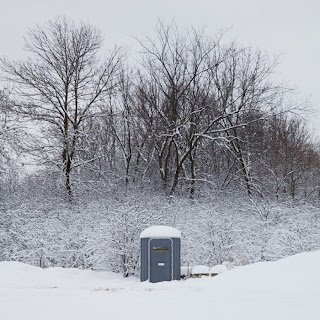 |
| County Grounds tree cutting |
The past year saw dispatches from Urban Wildernesses as far
flung as London, England and the U. S. Southwest, along with coverage of a wide
variety of stories much closer to home. Locally, 2013 was year of contrasts, of
gains and losses in terms of urban wilderness. The year began with a bang;
literally a crashing of trees and the whine of buzz saws at the Milwaukee
County Grounds in Wauwatosa. My January post, Slaughter
on the Milwaukee County Grounds: Innovation What?, struck a nerve and
blasted all records, both prior and subsequent, for Urban Wilderness readership.
Other bad news included the
proposed mine in the Bad River watershed of the Penokee Hills in northern
Wisconsin, the
precedent-setting decision by the WI Public Service Commission to allow
power lines to be built in Milwaukee County’s Underwood Parkway, a decision
by the WI DNR to expand hunting in the state, and a developer’s popular
proposal to build a residential tower on Milwaukee’s lakefront in
violation of Wisconsin’s Public Trust Doctrine. (The final outcomes of the
mine and the lakefront development are still pending.)
 |
| 3 Bridges Park opens |
On the positive side of the ledger, Milwaukee created two
fabulous new parks for its citizens to enjoy—3 Bridges Park in the Menomonee
Valley and the Rotary Centennial Arboretum along the Milwaukee River.
I posted twice about 3 Bridges Park: 3
Bridges Park opens in Menomonee Valley and Photos
of the opening.
 |
| Rotary Centennial Arboretum |
And three times to share images of the arboretum as it
developed during the year:
Also, people from all over the region continue to turn out
in great numbers to help Milwaukee Riverkeeper clean
up the rivers on Earth Day and the Menomonee River is finally going to be
rid of the last remaining stretch of concrete
channel.
Beyond all that it was another very good year for Urban
Wilderness adventures. Here are a few of my favorite chronicles in
chronological order:
January: An update on the tree-cutting episode at the
Milwaukee County Grounds.
 |
| Starved Rock State Park, IL |
In February I returned for a second look at Starved Rock
State Park, not far from Chicago in Illinois: The Abstract Wild.
In March I returned to the Mke County Grounds for An Easter reflection.
 |
| Hampstead Heath, London |
In May I reported on my April trip to London’s Hampstead
Heath: Nature, Art and Artifice.
June found me in the Southwest where I posted from Abiquiu,
NM—Desert monastery knows how to do seclusion—and southern Colorado—Colorful Colorado: a tale of tent caterpillars and pine beetles.
 |
| Millennium Reserve, Chicago, IL |
In July I discovered Chicago’s Millennium Reserve, which at
140,000 acres will become the nation’s largest urban wilderness when its
post-industrial landscape is fully rehabilitated: Chicago’s Millennium Reserve: A photo essay.
In August I finally made a long awaited pilgrimage to one of
the most famous of all urban wildernesses: Postcards from Walden Pond.
 |
| North Park, Lincolnshire, IL |
September found me off the beaten track—slightly—next to
Interstate 94 outside Chicago: North Park, Lincolnshire, IL: We all live in awatershed.
In October I was fortunate enough to be able to return to
New Mexico from where I filed this account of a visit to one of Georgia
O’Keeffe’s favorite sources of inspiration: The White Place.
 |
| County Grounds |
December was dark, as always, which led me to post twin
stories about the winter solstice.
I closed the year in the place where it began, with a photo essay from the Milwaukee County Grounds, which has become a white place of a
very different sort.
Happy New Year from the Urban Wilderness!








































